|
Have a safe day!
Thursday, May 6
2:30 p.m.
Theoretical Physics Seminar - Curia II
Speaker: Harald Fritzsch, Universitaet Muenchen
Title: Flavor Mixing, Neutrino Mixing and Neutrino Masses
3:30 p.m.
DIRECTOR'S COFFEE BREAK - 2nd Flr X-Over
THERE WILL BE NO ACCELERATOR PHYSICS AND TECHNOLOGY SEMINAR TODAY
Friday, May 7
11 a.m. - 12 p.m.
PPD/Neutrino Physics Discussion - Hornet's Nest, WH8XO
Title: Coherent Pion Production - The Berger-Sehgal Model
Speaker: Lalit Sehgal
3:30 p.m.
DIRECTOR'S COFFEE BREAK - 2nd Flr X-Over
THERE WILL BE NO JOINT EXPERIMENTAL-THEORETICAL PHYSICS SEMINAR THIS WEEK
Click here for NALCAL,
a weekly calendar with links to additional information.
Upcoming conferences |
|
For information about H1N1, visit Fermilab's flu information site.
|
|
Thursday, May 6
- Breakfast: Apple sticks
- Minnesota wild rice w/chicken
- Tuna melt on nine grain
- Italian meatloaf
- Chicken casserole
- Buffalo crispy chicken wrap
- Assorted sliced pizza
- Mandarin chicken
Wilson Hall Cafe Menu
|
|
Thursday, May 6
Dinner
- Pear and parmesan salad
- Steak au poivre
- Potato gratin
- Haricots verts
- Soufflé glace au grand marnier
Wednesday, May 12
Lunch
- Grilled tuna nicoise salad
- Blueberry yogurt sundaes
Chez Leon Menu
Call x3524 to make your reservation.
|
|
|
NuMI achieves new protons-on-target milestone
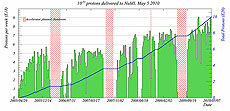 |
| This plot shows the weekly integrated NuMI protons on target from May 2005 to May 2010. |
Fermilab's Neutrinos at the Main Injector, or NuMI, achieved a milestone for total delivered protons on target during the morning of Wednesday, May 5. An accumulated 1021 protons have now been extracted from the Main Injector at 120 GeV for NuMI since the beginning of MINOS experimental operations in spring of 2005.
Sam Childress, NuMI coordinator, attributed the milestone to sustained high NuMI beam power and a consistently well run accelerator complex.
|
DZero collaborator Jan Stark wins Joliot-Curie prize
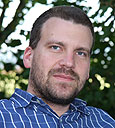 |
| Jan Stark |
DZero physicist Jan Stark was recently named the 2009 recipient of the Joliot-Curie Prize, an award given each year by the French Physical Society to a nuclear or particle physicist.
Stark won the award for his work on DZero and the BaBar experiment at SLAC National Accelerator Laboratory.
Stark conducted his Ph.D. thesis work at BaBar, where he contributed to the first measurement of the B meson lifetimes at Upsilson (4s) and to charge parity studies in rare b quark decays. In 2002 he came to DZero, where he worked on the experiment's calorimeter and the W boson mass measurement. The calorimeter is the most important sub-detector in the measurement of the W boson mass, which is a key parameter in the Standard Model. DZero precisely measured the W boson mass in 2009. |
Going green, getting back to nature at ES&H Fair
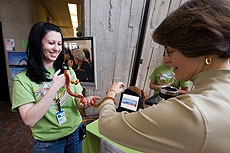 |
The Fermi Natural Areas' information table at the ES&H Fair, which took place on Thursday, April 29, included a live corn snake similar to those that can be found on site. Bridget Scerini of Technical Division is holding the snake and Marilyn Dixon of the Directorate is allowing it to slither across her wrist. |
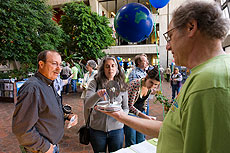 |
| Tim Trout of Fermilab and Mary Ann Cummins of Muons, Inc. visit the Fermilab Sustainable Energy Club table, staffed by Jim Zagel at the ES&H Fair held April 29 in the Wilson Hall atrium. |
|
Frontier guides computing through the collision landscape
The colossal particle detectors that monitor collisions at the Tevatron in Illinois and the Large Hadron Collider in Switzerland are unique beasts.
Scientists design most of the parts inside them to meet an individual set of specifications. But every once in a while, they find something the detectors can share.
Scientists at the CMS and ATLAS experiments at CERN are using a software system that Fermilab's Computing Division originally designed for the CDF experiment at the Tevatron. The system, called Frontier, helps scientists distribute at lightning speed information needed to interpret collision data. The system is based upon the widely used Squid web cache technology.
"Since data is often shared between sites or pulled from a remote site, the speed of data return is critical," said John DeStefano, an engineer at the RHIC and ATLAS Computing Facility at Brookhaven National Laboratory. "Not even the fastest database servers can bridge the physical gap between geographically disparate sites. People noticed how efficiently Frontier worked for CMS, and so far there has been a notable benefit for ATLAS as well."
Frontier caught on thanks to the interconnectedness of the particle physics community, said Fermilab engineer Liz Sexton-Kennedy. Many scientists now working on experiments at the LHC also worked on experiments at the Tevatron.
Read more
|
What's new with Buff 'n Blue
From Punahou School News,
May 3, 2010
Director of Fermilab to speak on 'studying the universe'
Pier Oddone, director of Fermi National Accelerator Laboratory, will give a free, public lecture for high school students about studying the universe on Friday, May 7, from 3:45 to 4:45 p.m. in Cornuelle Lecture Hall, Mamiya Science Center at Punahou School.
Oddone's presentation helps promote National Lab Day, May 12, a nationwide initiative that links teachers and scientists in an effort to spur hands-on scientific discovery by students in grades K-12. Seating for the lecture is limited. For reservations and information, please email Johannes Adams at jadams@punahou.edu.
Read more
|
|
|
Measuring pairs of light
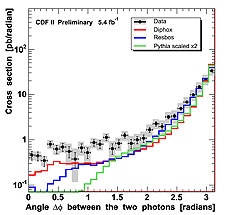 |
| This figure shows the photon pair-production probability (or cross section) as a function of the angle between the two photons in the event. The bars show the statistical uncertainty and the shaded areas the systematic uncertainty of the measurement. The data points are the CDF measurement and the red, blue and green curves are predictions of various theories. |
High-energy physicists seek to discover fundamental particles that could explain how our world is made. Examples of such particles are the Higgs boson, which could explain how matter acquires mass, and Randall-Sundrum gravitons, which could explain gravity and why it is so much weaker than the other forces in nature. By measuring the distributions of particles detected in proton-antiproton collisions, physicists advance their understanding of how these particles are produced. They also may learn whether the produced particles sometimes come from the creation and decay of undiscovered particles.
The detection of photons, the particle version of light, plays an important role by providing clean information about the proton-antiproton interactions. This is because photons produce an easily identifiable signal in the detector. In particular, events with two photons are of special interest because physicists expect particles such as the Higgs boson and the graviton to decay into two photons. Before it is possible to identify such decays, physicists need to understand and model all of the ways photon pairs can be produced.
A team of Fermilab physicists identified all events with photon pairs detected in the CDF detector and measured some of their properties. The team compared these results with predictions from theoretical models and found that none of them adequately describes all aspects of the measurements. An example is shown in the figure. The result of this study calls for further investigation of ways the photon pairs can be produced in order to support the searches of undiscovered particles at the Tevatron and the LHC.
- edited by Craig Group
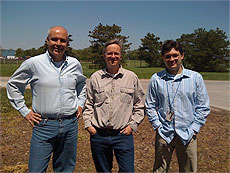 |
| The Fermilab scientists responsible for this analysis. From left to right: Costas Vellidis, Ray Culbertson and Sasha Pranko. |
|
Students find cosmic rays in D.C. museum
If you happen to be in the Washington, D.C., area today, stop in at the Smithsonian's Air and Space Museum to see cosmic rays in action in honor of National Lab Day.
Four teams of high school students and their teachers will display homemade cosmic ray detectors set up throughout the museum's Milestones of Flight Gallery. The detectors will record the particle remnants of the sun's energy that collide with the Earth's atmosphere and send secondary particle showers raining down through the roof. In fact, about a hundred of these secondary particles will pass through the bodies of museum visitors every second.
Visitors will get to learn about these cosmic rays, detectors, and the particle physics behind them from the students and a team of physicists from Fermilab and the QuarkNet education outreach program based at the Illinois laboratory.
Read more
|
|